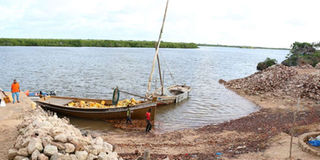Lamu's dilemma

Coral blocks mined at Manda Maweni awaiting transportation to Lamu Town, where they are a highly prized building material. PHOTO | LEOPOLD OBI | NATION MEDIA GROUP
In 1981, Joseph Ayugi and five of his friends working in a mining quarry in Likoni moved to Manda Island in Lamu at the suggestion of their foreman.
Ayugi says the foreman, who was from the Coast, told them the area was sitting on a colossal amount “white gold”.
“My foreman had surveyed the area and said it was endowed with coral stone, which was in high demand as a building material on the nearby island of Lamu. So we came and settled here in Manda Maweni, also known as Manda Ujaluoni,” says the 58-year-old.
True to the foreman’s words, underneath the lonely Island lay strata of white corals rocks, now in demand for building in Shela, Manda and Amu. The Island has become key to Lamu’s economy, providing coral blocks which are highly prized by developers in the town for construction.
When Ayugi and his friends arrived in Manda, the island was sparsely populated, comprising mainly mangrove forests and thickets, with wild animals such as elephants and buffaloes roaming freely.
However, the population has grown rapidly, with most of the people employed inthe coral mines.
“Today there are more than 1,800 people here from 12 tribes. We even have a school for our children,” offers George Otieno, who moved to the Island in 2000.
But the population increase has come with challenges.
“This village is now a residential settlement but we don’t have water or a health facility. We buy drinking water from Lamu Town, which is ferried by boat to the Island. We also go to Lamu Town for medical care,” he said.
Apart from its strength, coral is also a few degrees cooler than cement, making it an ideal building material in a region known for its hot climate.
Manda is one of the small islands situated off the north-eastern coast of Kenya, a few kilometres from Lamu Old Town Island, which was named a World Heritage Site in 2001 by the United Nations Educational, Scientific and Cultural Organisation (Unesco) in recognition of its distinct Swahili architecture and cultural values, which have been preserved for more than 700 years.
However, this heritage is constantly under pressure to modernise and re-develop, against the determination to remain an authentic town of yore. Devolution and development projects like the Lamu Port-South Sudan-Ethiopia-Transport (Lapsset) have taken the town by storm, leading to a population increase and the construction of new buildings.
Although devolution is a blessing to coral block miners because it has increased demand for the material, to the county government and conservatives, it is both a development opportunity and a threat to the county’s rich heritage.
Today, it is common to see boats offloading their cargo of coral blocks on Lamu Town waterfronts, from where they are transported to construction sites using donkeys.
As a heritage site, the development of new buildings is greatly discouraged within the historic district. There are even illustrated building regulations which provide guidelines for homeowners who wish to modify theirhouses or build new ones within the district, but some realtors openly flout the rules due to weak enforcement.
Population pressure, tourism and urbanisation have gradually influenced new developments, posing a serious conservation challenge to Kenya’s oldest town and its surrounding natural resources such as sand dunes, Lake Kenyatta and mangrove forests.
In 2010, the Global Heritage Fund identified Lamu as one of 12 sites in the world that were on the verge of irreparable loss and damage.
Acknowledging the challenges, Ms Amina Masoud Rashid, the Lamu County executive for Land, Physical Planning, Infrastructure, Urban development, Water and Natural Resources, said the county recently developed a spatial plan that lays down the framework for development in the area.
“We are hosting the LAPSSET project, which is attracting many investments, speculators and uncontrolled developments, “Mrs Rashid said, adding that speculation has led to encroachment on natural resources.
She added that the trickiest part of developing a spatial plan is public engagement because all the stakeholders and member sof the public must be involved, making it time-consuming and financially demanding.
“The document provides zones where each aspect of development takes place and it can also be used for enforcement purposes. For instance, the Mpeketoni area is marked out for agricultural production while Mukowe will be the new county headquarters,” she said, adding that with the new zones, development in the county will be regulated and orderly.
The county developed the plan with the support of environmental organisations such as the World Wide Fund for Nature (WWF). It was launched last week.
Presiding over the event, Lamu Governor Issa Timamy said that the plan will form the framework that will inform all the sectoral plans, including education, environment, health and agriculture.
Lamu, like many towns in the country, is grappling with a number of challenges including lack of proper drainage and sewerage systems, unregulated and unauthorised constructions, and inadequate housing. To help the counties tackle such challenges, the Constitution made it mandatory for every county to develop a spatial plan, but of the 47 counties, only Lamu has come up with a spatial plan that has been successfully launched.
Mohamed Awer, the Chief Executive Officer of WWF-Kenya, challenged other counties to learn from Lamu County, adding that his organisation will allocate resources to ensure that the implementation of the plan starts immediately.





